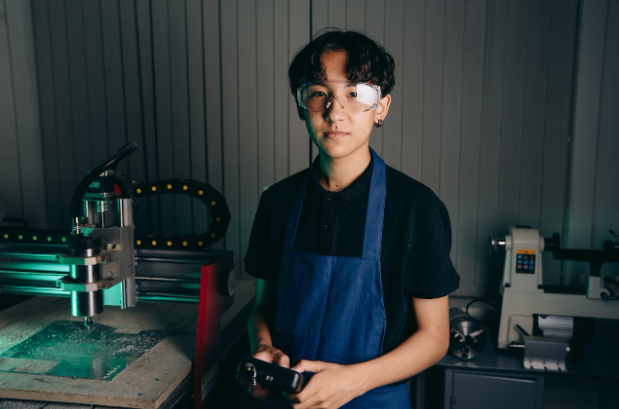Green CNC Machining: Sustainable Practices for a Better Future
Manufacturing processes are changing due to the emphasis on sustainability in the industrial landscape of today. CNC machining surfaces that integrate precision CNC technologies with eco-friendly methodologies are a pivotal response to this shift. In addition to reducing the carbon footprint of manufacturing operations, this innovative approach sets a new standard for efficiency and responsibility.
Green CNC machining extends beyond operational efficiency. By using renewable energy sources, such as solar and wind power, CNC machines can reduce their dependence on fossil fuels. This transition not only aligns with global sustainability goals but also offers manufacturers a pathway to lower energy costs and enhanced energy security.
Furthermore, the use of sustainable materials and waste reduction techniques are cornerstones of Green CNC Machining. Manufacturers can significantly reduce their environmental impact by optimizing material usage and embracing recycling initiatives. By conserving resources, these practices also promote a circular economy, where materials are reused as long as possible.
Sustainable Material Use and Waste Reduction in CNC Machining
By reducing waste and using sustainable materials in CNC machining, manufacturing practices can be aligned with environmental sustainability goals. It is based on several interconnected strategies aimed at minimizing resource depletion and reducing the industry’s carbon footprint.
Central to achieving these objectives is meticulous material management planning. The precise arrangement of parts on raw materials is enabled by sophisticated software techniques such as nesting and part optimization. In addition to conserving resources, it also significantly reduces waste generation, enhancing both material conservation and operational efficiency. By implementing efficient toolpaths and cutting strategies, these efforts are further enhanced, ensuring that each operation is streamlined to avoid unnecessary waste without compromising quality.
The recycling of metal scraps and shavings, the by-products of CNC machining processes, is essential in this sustainable ecosystem. By adopting comprehensive recycling protocols, manufacturers can turn potential waste into valuable resources. This process not only reduces the environmental burden associated with material disposal but also feeds back into the production cycle, reducing the demand for virgin raw materials. By implementing closed-loop systems for coolant recycling, we ensure that resources like coolants are reused, minimizing waste and promoting a more rational approach to resource management.
The combination of these strategies represents a holistic approach to sustainable material use and waste reduction in CNC machining. In addition to addressing environmental concerns, the industry positions itself at the forefront of sustainable manufacturing practices by prioritizing efficiency, recycling, and innovative waste management. By committing to green production, the company fosters a healthier planet and gains a competitive advantage in the market, proving that ecological responsibility and industrial success come hand in hand instead of being mutually exclusive.
Enhancing Energy Efficiency through Renewable Sources
In CNC machining, enhancing energy efficiency through the integration of renewable energy sources represents the next critical step in minimizing the carbon footprint of manufacturing operations. Solar, wind, and hydroelectric power all offer viable pathways for manufacturing facilities to reduce their reliance on fossil fuels, thereby reducing greenhouse gas emissions. The shift not only aligns with global sustainability targets, but it also reduces energy costs over time.
Energy-efficient CNC machines are at the forefront of this transformative movement. Thanks to energy-saving components and smarter operational algorithms, modern systems consume less power without compromising performance. As an example, advanced CNC machines can significantly reduce energy consumption when applied to tensile testing and tensile sample preparation, which is essential for evaluating materials’ mechanical properties. These machines optimize test speed, force, and duration to ensure precise results while minimizing energy consumption.
By optimizing processes and monitoring them in real-time, smart software solutions increase efficiency gains. With sophisticated algorithms, CNC operations can be fine-tuned to maximize energy efficiency. With real-time data analytics, inefficiencies can be identified immediately, allowing adjustments to be made swiftly. In addition to improving energy efficiency, this level of control and adaptability also boosts productivity and reduces operational costs.
A comprehensive approach to sustainability in manufacturing is exemplified by the integration of renewable energy, advanced CNC machines, and smart software solutions. It is possible to achieve operational excellence while reducing the impact of the industry on the planet when these technologies are embraced.
Implementing Eco-Friendly Technologies and Practices
As we delve deeper into sustainable manufacturing, implementing eco-friendly technologies and practices becomes crucial. The initiative integrates renewable energy sources and CNC machines but also deploys green technologies across all aspects of manufacturing. As previously mentioned, tensile testing processes are an example of this approach. Using eco-friendly technologies like those in tensile sample preparation CNC machines increases the sustainability of manufacturing operations without compromising precision or quality.
As a testament to the industry’s commitment to environmental stewardship, eco-friendly coolants, and lubricants are used in CNC machining. To reduce machining’s ecological impact, these substances minimize harmful emissions and waste. Similarly, closed-loop management of waste and coolant exemplifies a sustainable approach to resource utilization, ensuring recycling and reuse.
Additionally, smart software solutions can enhance sustainability. With these systems, manufacturers can optimize their operations for energy efficiency, monitor resource usage closely, and identify areas for improvement. With real-time data analysis and adaptive control, these software solutions ensure that manufacturing processes are not only more efficient but also less environmentally damaging.
As we conclude this exploration of green CNC machining, it’s clear that manufacturing’s future lies in sustainability. By integrating renewable energy, adopting energy-efficient machines, and implementing eco-friendly technologies and practices, the industry is poised to significantly reduce its environmental impact. Taking a holistic approach to sustainability reflects a commitment to preserving our planet as well as highlighting the need for innovation and adaptation to overcome the challenges faced by modern manufacturing. Now, cutting-edge CNC machining represents a critical step towards a more sustainable and environmentally conscious industry.

